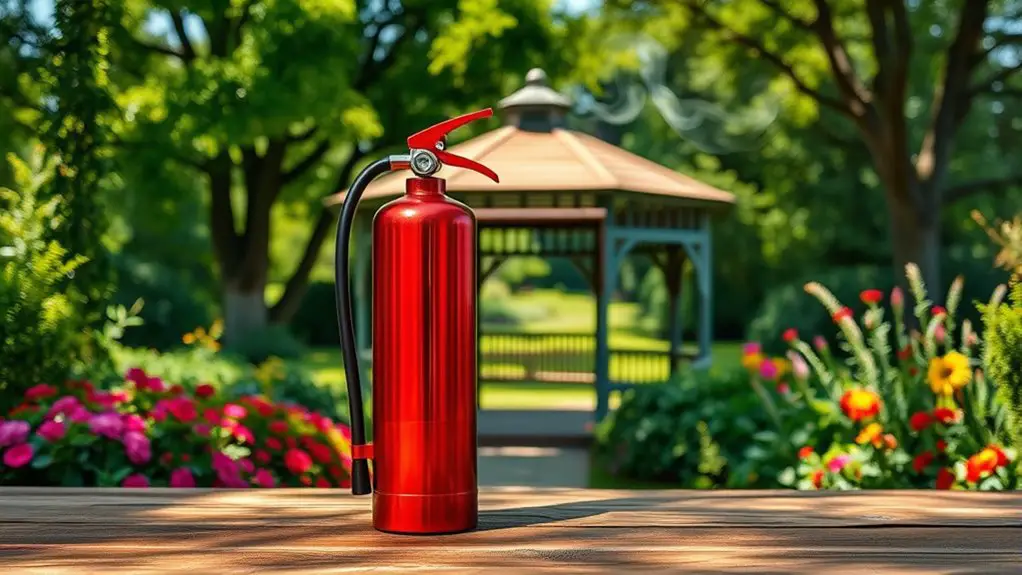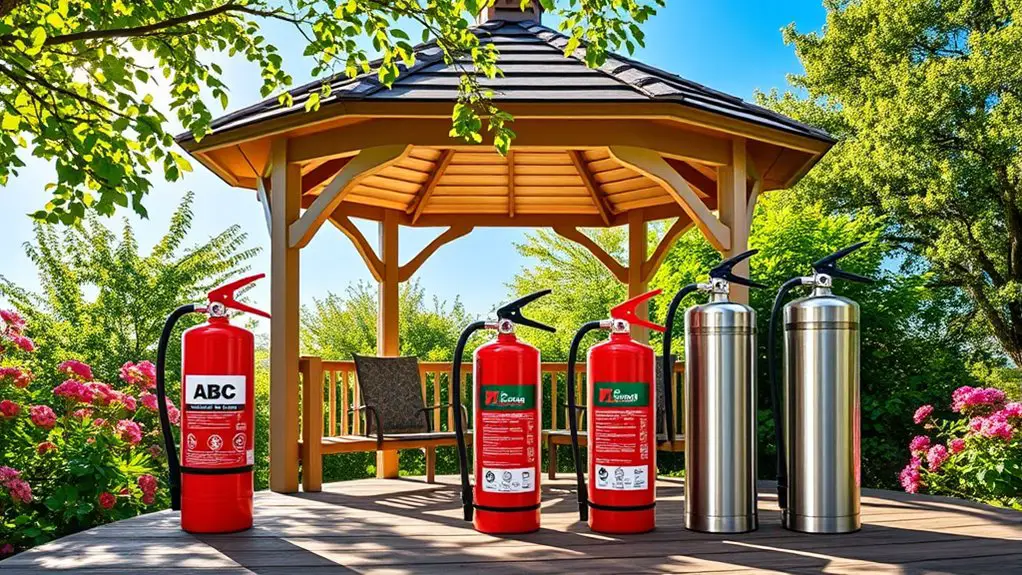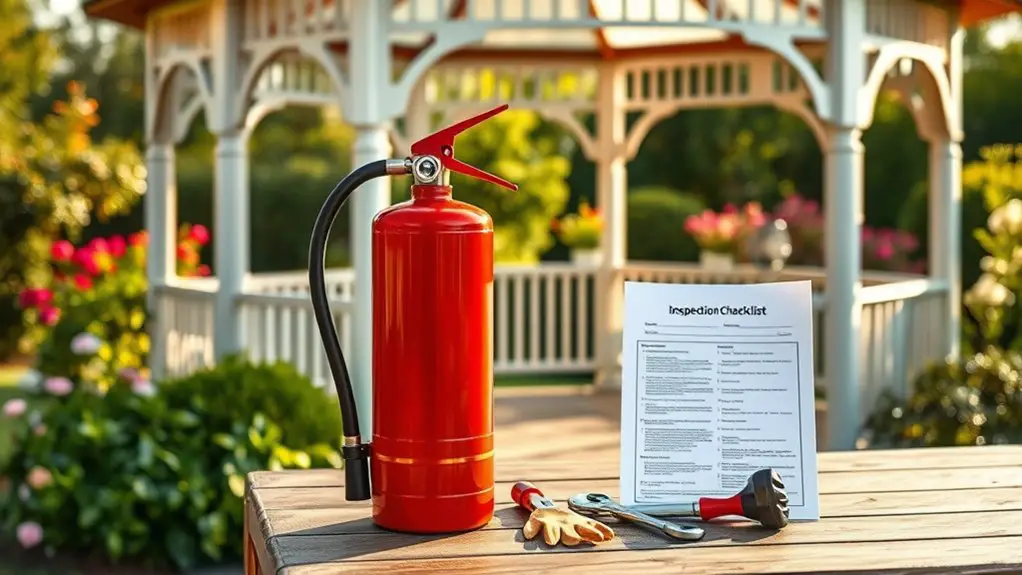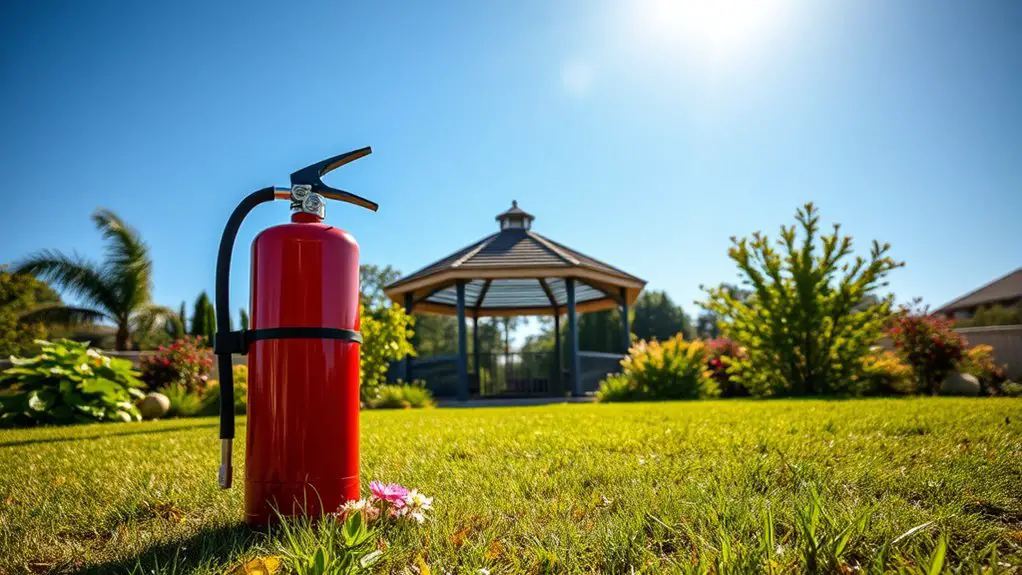For gazebo safety, the best fire extinguishers include ABC extinguishers for versatility, CO2 extinguishers for flammable liquids and electrical fires, and water mist extinguishers for safe use around people. Additionally, foam extinguishers effectively smother flammable liquid fires. Position extinguishers within 30 feet of potential hazards, ensuring they’re visible and accessible. Regular maintenance is essential to keep them ready for use. To learn more about specific fire risks and prevention strategies, keep exploring the details ahead.
Understanding Fire Risks in Gazebos

When you enjoy a gathering in your gazebo, it’s easy to overlook the potential fire hazards that can arise. Common fire causes include open flames from candles, grills, or nearby campfires, as well as electrical malfunctions from outdoor lighting. Unattended cooking can also spark a dangerous situation. To guarantee your safety, implementing proper safety precautions is crucial.
Start by keeping flammable materials, such as cushions and decorations, away from heat sources. Confirm your gazebo has adequate ventilation to disperse heat and smoke effectively. Installing smoke alarms and having a fire extinguisher nearby can greatly reduce the risk of fire-related emergencies. Regularly inspect electrical connections and maintain all appliances to prevent malfunctions. By being proactive and aware of these fire causes, you can enjoy your time in the gazebo with peace of mind, knowing you’ve taken the appropriate steps to safeguard yourself and your guests.
Types of Fire Extinguishers
Understanding the different types of fire extinguishers is essential for effective fire safety in a gazebo setting. Fire extinguisher classifications determine which type is appropriate for specific fire hazards. The most common classifications include Class A for ordinary combustibles, Class B for flammable liquids, Class C for electrical fires, and Class D for combustible metals.
For a gazebo, portable fire extinguishers are particularly advantageous due to their ease of use and mobility. You can quickly access them when a fire emergency arises. Additionally, consider multipurpose extinguishers, like those labeled ABC, which can handle a variety of fire types, making them versatile for your outdoor space.
Regularly check the pressure and functionality of your extinguishers to guarantee they’re ready for action. By understanding these classifications and selecting the right portable fire extinguishers, you can greatly enhance your gazebo’s fire safety.
Recommended Fire Extinguishers for Gazebo Use

Choosing the right fire extinguisher for your gazebo is essential for ensuring safety in outdoor gatherings. Different fire extinguisher types cater to various potential fire hazards, so you need to select one that suits your specific needs. For gazebo safety, consider the following options:
- ABC Extinguisher: Versatile for ordinary combustibles, flammable liquids, and electrical fires.
- CO2 Extinguisher: Ideal for flammable liquids and electrical fires, leaving no residue behind.
- Water Mist Extinguisher: Safe for use around people and effective on Class A fires.
- Foam Extinguisher: Great for flammable liquid fires, creating a barrier to smother flames.
Proper Placement and Accessibility
Proper placement and accessibility of fire extinguishers in your gazebo are essential for effective emergency response. You should position extinguishers within easy reach, ideally no more than 30 feet from any potential fire source, such as grills or heating devices. Verify fire extinguisher placement is clearly visible and not obstructed by furniture or decorations.
Follow accessibility guidelines by mounting extinguishers at a height that’s easy for everyone to access, typically between 3.5 and 5 feet above the ground. This height allows adults to grab them quickly while remaining accessible for teens or those with limited mobility.
Regularly check that the extinguishers are in good condition and easily reachable. If you’re hosting gatherings, consider informing guests about their locations. By adhering to these placement and accessibility guidelines, you enhance safety and empower yourself and others to respond effectively in an emergency.
Maintenance Tips for Fire Extinguishers

While it’s important to have fire extinguishers readily accessible in your gazebo, maintaining them in ideal condition is equally important. Regular upkeep guarantees they function correctly when you need them most. Here are some vital maintenance tips:
Having fire extinguishers in your gazebo is essential, but regular maintenance ensures they work when you need them most.
- Inspection Frequency: Check your extinguishers monthly for any visible signs of damage or corrosion.
- Pressure Check: Verify the pressure gauge needle is in the green zone, indicating it’s charged and ready to use.
- Recharge Guidelines: After any discharge, even partial, have your extinguisher recharged by a professional.
- Annual Maintenance: Schedule an annual inspection with a certified technician to confirm compliance with safety standards.
Frequently Asked Questions
Can I Use My Home Fire Extinguisher in the Gazebo?
You can use your home fire extinguisher in the gazebo, provided it’s compatible with the identified gazebo fire risks. Ascertain it’s suitable for the specific type of fire you might encounter to guarantee effective response.
How Often Should I Inspect My Fire Extinguisher?
You should inspect your fire extinguisher monthly for any signs of damage or pressure loss. Regular maintenance tips include checking the gauge, ensuring the nozzle is clear, and verifying accessibility—keeping safety a priority in your space.
Are There Fire Extinguishers Specifically for Outdoor Use?
Yes, there are outdoor fire extinguishers designed to meet fire safety regulations. These extinguishers typically handle various fire types, ensuring you’re prepared for emergencies while enjoying your outdoor activities and maintaining safety wherever you go.
What Is the Lifespan of a Typical Fire Extinguisher?
Ever wondered how long your fire extinguisher’s got left? Typically, they last 5 to 15 years. Regular fire extinguisher maintenance and adhering to fire safety regulations guarantee peak performance and safety when you need it most.
Can I Refill My Fire Extinguisher Myself?
You shouldn’t refill your fire extinguisher yourself. Proper fire extinguisher maintenance requires professional service for safety, ensuring the unit’s functional integrity and compliance with regulations. Always consult a certified technician to handle refills and inspections.

